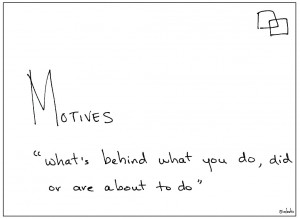Motivating others, asking for their motives and offering motive accounts are central features of social organization (Blum & McHugh, 1971; Housley & Fitzgerald, 2008; Mills, 1940). Journal of Comparative Research in Anthropology and Sociology – Compaso invites papers that explore the uses of motives in various spheres of day-to-day, professional and scientific life, for its Winter 2013 issue.
Guest Editor: Richard Fitzgerald, University of Queensland
Deadline for manuscript submission (extended): July 31, 2013
Volume publication (online): December 15, 2013
Send articles, research notes, essays, and book reviews to: compaso@compaso.eu
Please distribute this CfP: pdf version
Asking for motives and offering motives
As a rule, people present motives if challenged to account for their behaviour. People make use of vocabularies of motive (Mills, 1940) to present (meaningful and justified) actions to other people who stand to evaluate them. The motives asked for and motives given in return are shaped in three different contexts (Johnatan Potter & Hepburn, 2008):
- A rhetorical context: one formulates motives with an eye to the plausibility of alternative versions, some of which one may want to entertain, and some of which one may want to undermine;
- An interactional context: people give motives as specific answers to specific questions, as part of ongoing interaction in which they have something at stake;
- An institutional context: the interactions in which people are asked to formulate motives may vary widely as regards their accountability rules; one can be in a school, at the doctors, in a Courtroom, with a counselor, at Alcoholic Anonymous, etc.
Some research questions that may address this topic include (without being by any means exclusive):
1) What are the vocabularies of motive or interpretive repertoires (Jonathan Potter & Wetherell, 1987) associated with a given type of action (such as smoking, accepting a scientific theory, divorcing etc.)?
2) How are motives used to coordinate interaction?
3) How are motives rhetorically formulated, in order to support a version of reality in interaction with specific interlocutors in specific situations?
Motives and motivation
People often anticipate specific reactions to specific actions, including answers to questions about motives. They design some activities such as to ‘motivate’ other people in a certain direction, to frame their situations and environments in order to direct them. Such ‘motivational’ actions make visible the order on which they are based, the order that grounds expectations.
Possible questions related to this topic include:
1) How do people present a specific situation or action to others, in order to motivate them to react in a preferred way?
2) What are the lay and (quasi-)scientific theories of motivation that people bring to bear in their daily interactions with others?
3) How are motives embedded in objects? How do users adapt and react to these pre-programmed motives?
Working with motives as a professional
There is a vast body of research and literature on motivation, including motivating oneself, in fields such as psychology, sociology, consumer research, human resources, human-computer interaction, education studies and so on. Some motivational schemes have reached global fame, including Maslow’s pyramid of motives or Hertzberg’s hygiene or motivational factors. Professionals in various fields design, apply and evaluate complex models of human motivation, and embed them in their more-or-less material products.
We welcome papers that discuss the production and use of professional vocabularies of motive, and the reactions of various publics to the socio-technical systems that put them into practice. Some guiding questions include:
- How do we (and other specialists) study motives, in disciplinary and interdisciplinary research?
- How do professionals’ public products (technologies, policies, clothing, scientific theories…) incorporate specific models of human motivation?
- What is the ‘moral career’ of motivational classifications, in various spheres of life – such as Maslow’s pyramid, or the distinction between intrinsic and extrinsic motivation?
- How do we encounter and react to professional motivational designs in various institutional environments?
References
Blum, A. F., & McHugh, P. (1971). The Social Ascription of Motives. American Sociological Review, 36(1), 98–109.
Housley, W., & Fitzgerald, R. (2008). Motives and social organization: sociological amnesia, psychological description and the analysis of accounts. Qualitative Research, 8(2), 237–256.
Mills, C. W. (1940). Situated Actions and Vocabularies of Motive. American Sociological Review, 5(6), 904–913.
Potter, Johnatan, & Hepburn, A. (2008). Discursive constructionism. In J. A. Holstein & J. F. Gubrium (Eds.), Handbook of constructionist research (pp. 275–293). New York: Guildford.
Potter, Jonathan, & Wetherell, M. (1987). Discourse and social psychology: beyond attitudes and behaviour (p. 216). London: Sage.
This Call for Papers is supported by the research project “Sociological imagination and disciplinary orientation in applied social research”, with the financial support of ANCS / UEFISCDI with grant no. PN-II-RU-TE-2011-3-0143, contract 14/28.10.2011.

